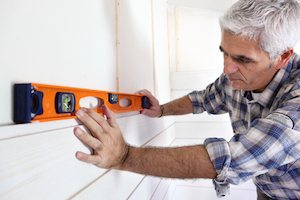DIY Yearly Home Inspection Tips

- Outdoors. The outer area of your home, whether small or large, is a good place to start. The grading of your home should slope away from your foundation at least six inches within the first ten feet. If anything, the slope should be even greater than this. If you are experiencing any water or flooding in your basement, there is a possibility of poor grading outside. Other key issues to look for outdoors are standing water, branches or shrubs scrapping the house, fence condition, and concrete slabs with cracks.
- Indoors. Throughout the interior of your home, there are a variety of places you should be examining when completing your DIY home inspection. Start in your attic. Check for stains on the ceiling (which could indicate a leak), decaying or rotting wood, and take a look at the electrical wires. Also, keep your eyes peeled for anything out of the ordinary. If something doesn’t look quite right, call a professional. As you move through your home inspection, look at the walls and ceiling for cracks and whether they are level. All doors and windows should open and shut without force, and heating and cooling should be flowing throughout each room. Also, make sure that the lights are working properly and all water sources are running efficiently. Check for stains underneath sinks indicating possible water leaks. Keep in mind that there are other areas to review during your home inspection, these are just a start.
- Miscellaneous. There are a few things to check no matter what room you are inspecting. Look for caulking in good condition, evidence of moisture where it shouldn’t be, and check for surface cracks. Check smoke and carbon dioxide detectors, visible wiring, and be sure that heating and cooling systems are operating without excessive noise and with a clean air filter. Also, walk around to see if you detect odors coming from your heating and cooling systems. This is a possible sign of improper care that should be addressed by a professional.
Now that you have these tips, walk around your home and look for signs of general wear and tear. It’s important to catch small issues before they become big problems. Being proactive about maintenance can help you save on repair costs when you decide to sell your home at some point in the future. If you come across an issue that doesn’t seem right, consult a professional. It’s better to be safe in your home, than sorry that you didn’t address an issue when it first arose. If you come across any issues that require further inspection by a professional, set up a home inspection with us at Inspect-It 1st®! We will inspect the interior and exterior of your home to make sure you and your family have a safe and happy space to call home.
